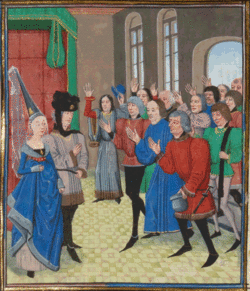On 30 April 1341, John III, Duke of Brittany, died without a male heir. His half-brother, John of Montfort, claimed the the succession, however France supported Jeanne of Penthièvre, niece of Jean III and wife of Charles of Blois, himself a nephew of the King Philippe VI
The Duchy of Brittany historically had a "semi-Salic" mode of inheritance; male primogeniture was followed unless no direct male descendants remained. At that point the closest female descendant inherited as duchess, with her husband serving as duke by "right of representation". The position of John of Montfort was legally founded on the belief that a brother (even a half-brother) was a closer heir than a beneficiary niece, and that the Salic form of inheritance adopted by the Kingdom of France should be followed. This argument was based on the fact that since 1297 Brittany had been a duché-pairie ("member and part of the crown"), and that the legislation of the suzerain kingdom should therefore be applied.Challenges to the Salic law of the Franks had historically been rejected for the Kingdom of France, allowing Philippe V to gain the throne in 1316, and Philippe VI most recently. This made Edward III's support of Jean of Montfort quite ironic, in that the argument for Edward III to inherit the Kingdom of France was based on the opposing philosophy that the crown should be able to descend through a female line.
A civil war, termed the War of the Breton Succession, then began and lasted 23 years. T
After the funeral of Jean III, He went to Limoges where he obtainedthe ducal treasury. In Nantes he recognised as Duke in May 1341 by an assembly composed of members of the towns and minor nobles, but shunned by the major vassals with the exception of Hervé VII, Count of Léon. Thanks to the ducal treasury, he recruited mercenaries which allowed him to perform in June and July a 'great ride in Brittany' (as described by Arthur de la Borderie) and take control of the Duchy.
Charles of Blois then made an appeal to Philippe VI, who summoned Jean of Montfort to a Court of Peers session in Conflans in September 1341 which awarded the Duchy to Charles of Blois. Philippe VI agreed to receive l'hommage lige of Charles of Blois on behalf of his wife, and confiscated from John of Montfort the French lands of the County of Montfort-l'Amaury, as well as the Viscounty of Limoges .
In October 1341, Charles of Blois supported by France penetrated into Brittany. They managed to retrieve a number of strongholds which had been lost, including Nantes, which relented on 21 November 1341 after three weeks of siege. Jean of Montfort was captured and imprisoned in the Louvre in Paris leaving his wife to continue the struggle
In January 1343, through Pope Clement VI, a truce was signed at Malestroit to bring peace and the liberation of Jean of Montfort. He was released in September 1343 and continued the struggle with reinforcements provided by England . He died of an illness in Hennebont having unsuccessfully laid siege to Quimper 1345
He was buried in the convent of the Dominicans of Quimperlé where his tomb, which had already been desecrated, was found again in December 1883.His remains are now in the Church of Sainte-Croix de Quimperlé.
On 30 April 1341, John III, Duke of Brittany, died without a male heir. His half-brother, John of Montfort, claimed the the succession, however France supported Jeanne of Penthièvre, niece of Jean III and wife of Charles of Blois, himself a nephew of the King Philippe VI
The Duchy of Brittany historically had a "semi-Salic" mode of inheritance; male primogeniture was followed unless no direct male descendants remained. At that point the closest female descendant inherited as duchess, with her husband serving as duke by "right of representation". The position of John of Montfort was legally founded on the belief that a brother (even a half-brother) was a closer heir than a beneficiary niece, and that the Salic form of inheritance adopted by the Kingdom of France should be followed. This argument was based on the fact that since 1297 Brittany had been a duché-pairie ("member and part of the crown"), and that the legislation of the suzerain kingdom should therefore be applied.Challenges to the Salic law of the Franks had historically been rejected for the Kingdom of France, allowing Philippe V to gain the throne in 1316, and Philippe VI most recently. This made Edward III's support of Jean of Montfort quite ironic, in that the argument for Edward III to inherit the Kingdom of France was based on the opposing philosophy that the crown should be able to descend through a female line.
A civil war, termed the War of the Breton Succession, then began and lasted 23 years. T
After the funeral of Jean III, He went to Limoges where he obtainedthe ducal treasury. In Nantes he recognised as Duke in May 1341 by an assembly composed of members of the towns and minor nobles, but shunned by the major vassals with the exception of Hervé VII, Count of Léon. Thanks to the ducal treasury, he recruited mercenaries which allowed him to perform in June and July a 'great ride in Brittany' (as described by Arthur de la Borderie) and take control of the Duchy.
Charles of Blois then made an appeal to Philippe VI, who summoned Jean of Montfort to a Court of Peers session in Conflans in September 1341 which awarded the Duchy to Charles of Blois. Philippe VI agreed to receive l'hommage lige of Charles of Blois on behalf of his wife, and confiscated from John of Montfort the French lands of the County of Montfort-l'Amaury, as well as the Viscounty of Limoges .
In October 1341, Charles of Blois supported by France penetrated into Brittany. They managed to retrieve a number of strongholds which had been lost, including Nantes, which relented on 21 November 1341 after three weeks of siege. Jean of Montfort was captured and imprisoned in the Louvre in Paris leaving his wife to continue the struggle
In January 1343, through Pope Clement VI, a truce was signed at Malestroit to bring peace and the liberation of Jean of Montfort. He was released in September 1343 and continued the struggle with reinforcements provided by England . He died of an illness in Hennebont having unsuccessfully laid siege to Quimper 1345
He was buried in the convent of the Dominicans of Quimperlé where his tomb, which had already been desecrated, was found again in December 1883.His remains are now in the Church of Sainte-Croix de Quimperlé.
Family Members
Advertisement
See more Anti Duke of Brittany or de Montfort memorials in:
- Abbaye Sainte-Croix Anti Duke of Brittany or de Montfort
- Quimperle Anti Duke of Brittany or de Montfort
- Departement du Finistère Anti Duke of Brittany or de Montfort
- Bretagne Anti Duke of Brittany or de Montfort
- France Anti Duke of Brittany or de Montfort
- Find a Grave Anti Duke of Brittany or de Montfort
Advertisement









